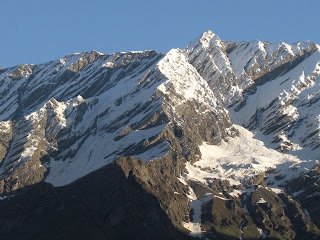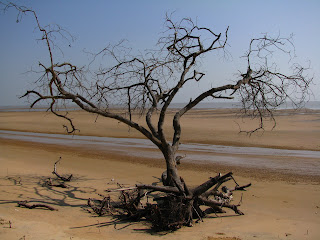Kumayun Himalaya – called “Deva-bhumi” was our ultimate destination in early winter, Pindari glacier. The virgin beauty of Pindari glacier trekking moves us to heaven. To grasp more tightly the hidden paradise we started our journey on 10
th November from
howrah station.
There are so many routes to reach the last metorable spot –Loharkhet village. Haldoani or Kathgodam is the nearest railway station. We started our journey from Tanakpur. We went first to Bageshwar, a busy hilly market area. We stayed at Hotel Siddharth near bus stop with a moderate hotel fair. You can get a clear view of Gomoti River from this hotel. Bageshwar is a spiritual place as it has ancient
temple of Bagnath beside the confluence of two rivers Gomoti and Sarju.
We took our daily food stuffs and kerosene for coming 8 days. We brought stove and cooking utensils from Kolkata. As we are going this route in off season had to take these stuffs otherwise you can get lunch-dinner on the way. The top season is May-September.
Next morning after a huge packing we moved towards Loharkhet by jeep, 42 kms away from Bageshwar. From Varari we had a glimpse of snow capped peaks- Nandakot, Kafni, Changuch etc. At Loharkhet we stayed in KMVN rest house 1.5km from village Loharkhet. Through the whole trekking we availed KMVN rest house with a rate of Rs.100 per person.
Day 1 – Early morning we started our trekking to the farthest corner of Himalayas, in the lap of Nanda-devi twin peak, Pindari glacier (3660mtrs). We covered 11kms that day to reach Dhakuri(2683mtrs). We had to cross Dhakuri pass (9300feet).
From Dhakuri pass we got bird’s eye view of a huge range –Nandakot, Nandakhat, Miketoli, Panwalidwar, Suderdunga etc. The fresh breath and tenderness of eyes removed the tremendous fatigue. We sipped hot mixed vegetables soup and enjoyed golden sunset on Nandakot from KMVN rest house.
Day 2 – Khati was our next destination, 9 kms away. On our way we enjoyed stage cultivation, dense forest and gurgling mountain streams. The village people really made our day with their smiling face. Their cheerful voice and facial expression welcome us to the land of Nandadevi. Khati is the last village of this trek route.
Day 3 – Early morning we move for Dwali, 12 kms from Khati. This road is fully through unending dense forest where we saw white monkeys gazing at us so curiously. Pindar river is our all time- all day friend from Khati. Dancing Pindar will engulf all your fatigue. Several times you have to cross the river by wooden broken bridge. This was very much thrilling for us. We collected lots of walnut from this forest. Our guide told us about the dense wildlife – Beer, Monkeys, Fox, Mountain goat, Himalayan snakes, Bison, Porcupine etc. Around 3pm. We reached Dwali rest house and enjoyed the breathtaking spectacular view of Nandadevi east.

Day 4 – Because of off season we had to move on to Pindari zero point and back in one day, 24 kms, as the in between Phurkiya rest house was closed, which is 5 kms away from Dwali. These 24 kms seemed to us an impossible task but mental strength pulled us to our destination. During the 12 kms up I got serious headache because of empty stomach and dehydration. But the beauty of nature wiped our fatigue – barren hills covered with wild bushes and pale grasses, snow capped mountains, amazing rock surface( perfect for climbing), hide and seek with sunlight, mountain streams and water falls, deep rocky gorges of Pindar – all these things were mesmerizing. The mystic maze of adventure dragged us to the destination. We had a rare view of Mount Baljouri near Phurkiya.



1 km before zero point there is Swami Dharmanada ashram where we had hot tea, mouthwatering Khichuri and hot water, only after that I could grasp camera. Everywhere I felt a spiritual presence you believe or not. I never realized this type of heavenly presence of Almighty before. The landscapes seemed to me art work of God on a huge canvas.
We had to rush immediate after having lunch because of bad weather. We almost ran and jumped across boulders as the sun is setting down. The last glow of setting sun was spreading everywhere.
Day 5 – We experienced snowfall this morning at Dwali and walking with snow falling from hazy sky really made our trip full. Soft snow covered our entire body.
After that 2 days of trekking brought us to Loharkhet. Carrying a flooded heart with memories we had to return to home-sweet-home. And now this is like a dream come true.






































